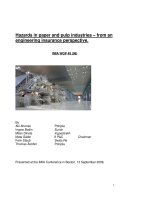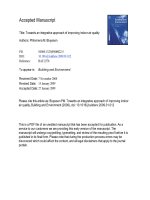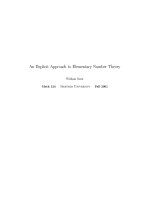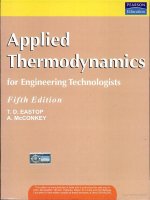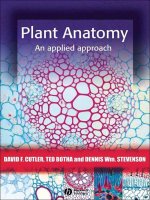Thermodynamics an engineering approach yunus çengel, michael boles 5th edition
Bạn đang xem bản rút gọn của tài liệu. Xem và tải ngay bản đầy đủ của tài liệu tại đây (22.46 MB, 964 trang )
www.elsolucionario.org
Chapter 1
Introduction and Basic Concepts
1-1 Thermodynamics and Energy
Application Areas of Thermodynamics
1-2 Importance of Dimensions and Units
Some SI and English Units
Dimensional Homogeneity
Unity Conversion Ratios
1-3 Systems and Control Volumes
1-4 Properties of a System
Continuum
1-5 Density and Specific Gravity
1-6 State and Equilibrium
The State Postulate
1-7 Processes and Cycles
The Steady-Flow Process
1-8 Temperature and the Zeroth Law of Thermodynamics
Temperature Scales
The International Temperature Scale of 1990 (ITS-90)
1-9 Pressure
Variation of Pressure with Depth
1-10 The Manometer
Other Pressure Measurement Devices
1-11 The Barometer and Atmospheric Pressure
1-12 Problem-Solving Technique
Step 1: Problem Statement
Step 2: Schematic
Step 3: Assumptions and Approximations
Step 4: Physical Laws
Step 5: Properties
Step 6: Calculations
Step 7: Reasoning, Verification, and Discussion
Engineering Software Packages
A Remark on Significant Digits
Summary
References and Suggested Reading
Problems
Chapter 2
Energy Conversion and General Energy Analysis
2-1 Introduction
2-2 Forms of Energy
Some Physical Insight to Internal Energy
Mechanical Energy
More on Nuclear Energy
2-3 Energy Transfer by Heat
Historical Background on Heat
2-4 Energy Transfer by Work
Electrical Work
2-5 Mechanical Forms of Work
Shaft Work
Spring Work
Work Done on Elastic Solid Bars
Work Associated with the Stretching of a Liquid Film
Work Done to Raise or to Accelerate a Body
Nonmechanical Forms of Work
2-6 The First Law of Thermodynamics
Energy Balance
Energy Change of a System, ∆Esystem
Mechanisms of Energy Transfer, Ein and Eout
2-7 Energy Conversion Efficiencies
2-8 Energy and Environment
Ozone and Smog
Acid Rain
The Greenhouse Effect: Global Warming and Climate Change
Topic of Special Interest: Mechanisms of Heat Transfer
Summary
References and Suggested Reading
Problems
Chapter 3
Properties of Pure Substances
3-1 Pure Substance
www.elsolucionario.org
3-2 Phases of a Pure Substance
3-3 Phase-Change Processes of Pure Substances
Compressed Liquid and Saturated Liquid
Saturated Vapor and Superheated Vapor
Saturation Temperature and Saturation Pressure
Some Consequences of Tsat and Psat Dependence
3-4 Property Diagrams for Phase-Change Processes
1 The T-v Diagram
2 The P-v Diagram
Extending the Diagrams to Include the Solid Phase
3 The P-T Diagram
The P-v-T Surface
3-5 Property Tables
Enthalpy—A Combination Property
1a Saturated Liquid and Saturated Vapor States
1b Saturated Liquid–Vapor Mixture
2 Superheated Vapor
3 Compressed Liquid
Reference State and Reference Values
3-6 The Ideal-Gas Equation of State
Is Water Vapor an Ideal Gas?
3-7 Compressibility Factor—A Measure of Deviation from Ideal-Gas
Behavior
3-8 Other Equations of State
Van der Waals Equation of State
Beattie-Bridgeman Equation of State
Benedict-Webb-Rubin Equation of State
Virial Equation of State
Topic of Special Interest
Vapor Pressure and Phase Equilibrium
Summary
References and Suggested Reading
Problems
Chapter 4
Energy Analysis of Closed Systems
4-1 Moving Boundary Work
Polytropic Process
4-2 Energy Balance for Closed Systems
4-3 Specific Heats
4-4 Internal Energy, Enthalpy, and Specific Heats of Ideal Gases
Specific Heat Relations of Ideal Gases
4-5 Internal Energy, Enthalpy, and Specific Heat of Solids and Liquids
Internal Energy Changes
Enthalpy Changes
Topic of Special Interest: Thermodynamic Aspects of Biological Systems
Summary
References and Suggested Reading
Problems
Chapter 5
Mass and Energy Analysis of Control Volumes
5-1 Conservation of Mass
Mass and Volume Flow Rates
Conservation of Mass Principle
Mass Balance for Steady-Flow Processes
Special Case: Incompressible Flow
5-2 Flow Work and the Energy of a Flowing Fluid
Total Energy of a Flowing Fluid
Energy Transport by Mass
5-3 Energy Analysis of Steady-Flow Systems
Energy Balance
5-4 Some Steady-Flow Engineering Devices
1 Nozzles and Diffusers
2 Turbines and Compressors
3 Throttling Valves
4a Mixing Chambers
4b Heat Exchangers
5 Pipe and Duct Flow
5-5 Energy Analysis of Unsteady-Flow Processes
Mass Balance
Energy Balance
Topic of Special Interest: General Energy Equation
Summary
References and Suggested Reading
Problems
www.elsolucionario.org
Chapter 6
The Second Law of Thermodynamics
6-1 Introduction to the Second Law
6-2 Thermal Energy Reservoirs
6-3 Heat Engines
Thermal Efficiency
Can We Save Qout ?
The Second Law of Thermodynamics: Kelvin–Planck Statement
6-5 Refrigerators and Heat Pumps
Coefficient of Performance
Heat Pumps
The Second Law of Thermodynamics: Clausius Statement
Equivalence of the Two Statements
6-6 Perpetual-Motion Machines
6-7 Reversible and Irreversible Processes
Irreversibilities
Internally and Externally Reversible Processes
6-8 The Carnot Cycle
The Reversed Carnot Cycle
6-9 The Carnot Principles
6-10 The Thermodynamic Temperature Scale
6-11 The Carnot Heat Engine
The Quality of Energy
Quantity versus Quality in Daily Life
6-12 The Carnot Refrigerator and Heat Pump
Topics of Special Interest: Household Refrigerators
Summary
References and Suggested Reading
Problems
Chapter 7
Entropy
7-1 Entropy
A Special Case: Internally Reversible Isothermal Heat Transfer
Processes
7-2 The Increase of Entropy Principle
Some Remarks about Entropy
7-3 Entropy Change of Pure Substances
7-4 Isentropic Processes
7-5 Property Diagrams Involving Entropy
7-6 What Is Entropy?
Entropy and Entropy Generation in Daily Life
7-7 The T ds Relations
7-8 Entropy Change of Liquids and Solids
7-9 The Entropy Change of Ideal Gases
Constant Specific Heats (Approximate Analysis)
Variable Specific Heats (Exact Analysis)
Isentropic Processes of Ideal Gases
Constant Specific Heats (Approximate Analysis)
Variable Specific Heats (Exact Analysis)
Relative Pressure and Relative Specific Volume
7-10 Reversible Steady-Flow Work
Proof that Steady-Flow Devices Deliver the Most and Consume the Least
Work when the Process Is Reversible
7-11 Minimizing the Compressor Work
Multistage Compression with Intercooling
7-12 Isentropic Efficiencies of Steady-Flow Devices
Isentropic Efficiency of Turbines
Isentropic Efficiencies of Compressors and Pumps
Isentropic Efficiency of Nozzles
7-13 Entropy Balance
Entropy Change of a System, ∆S system
Mechanisms of Entropy Transfer, Sin and Sout
1 Heat Transfer
2 Mass Flow
Entropy Generation, Sgen
Closed Systems
Control Volumes
Entropy Generation Associated with a Heat Transfer Process
Topics of Special Interest: Reducing the Cost of Compressed Air
Summary
References and Suggested Reading
Problems
www.elsolucionario.org
Chapter 8
Exergy: A Measure of Work Potential
8-1 Exergy: Work Potential of Energy
Exergy (Work Potential) Associated with Kinetic and Potential Energy
8-2 Reversible Work and Irreversibility
8-3 Second-Law Efficiency, ηII
8-4 Exergy Change of a System
Exergy of a Fixed Mass: Nonflow (or Closed System) Exergy
Exergy of a Flow Stream: Flow (or Stream) Exergy
8-5 Exergy Transfer by Heat, Work, and Mass
Exergy Transfer by Heat Transfer, Q
Exergy Transfer by Work, W
Exergy Transfer by Mass, m
8-6 The Decrease of Exergy Principle and Exergy Destruction
Exergy Destruction
8-7 Exergy Balance: Closed Systems
8-8 Exergy Balance: Control Volumes
Exergy Balance for Steady-Flow Systems
Reversible Work, W rev
Second-Law Efficiency of Steady-Flow Devices, ηII
Topics of Special Interest: Second-Law Aspects of Daily Life
Summary
References and Suggested Reading
Problems
Chapter 9
Gas Power Cycles
9-1 Basic Considerations in the Analysis of Power Cycles
9-2 The Carnot Cycle and Its Value in Engineering
9-3 Air-Standard Assumptions
9-4 An Overview of Reciprocating Engines
9-5 Otto Cycle: The Ideal Cycle for Spark-Ignition Engines
9-6 Diesel Cycle: The Ideal Cycle for Compression-Ignition Engines
9-7 Stirling and Ericsson Cycles
9-8 Brayton Cycle: The Ideal Cycle for Gas-Turbine Engines
Development of Gas Turbines
Deviation of Actual Gas-Turbine Cycles from Idealized Ones
9-9 The Brayton Cycle with Regeneration
9-10 The Brayton Cycle with Intercooling, Reheating, and Regeneration
9-11 Ideal Jet-Propulsion Cycles
Modifications to Turbojet Engines
9-12 Second-Law Analysis of Gas Power Cycles
Topics of Special Interest: Saving Fuel and Money by Driving Sensibly
Summary
References and Suggested Reading
Problems
Chapter 10
Vapor and Combined Power Cycles
10-1 The Carnot Vapor Cycle
10-2 Rankine Cycle: The Ideal Cycle for Vapor Power Cycles
Energy Analysis of the Ideal Rankine Cycle
10-3 Deviation of Actual Vapor Power Cycles from Idealized Ones
10-4 How Can We Increase the Efficiency of the Rankine Cycle?
Lowering the Condenser Pressure (Lowers T low,av)
Superheating the Steam to High Temperatures (Increases Thigh,av)
Increasing the Boiler Pressure (Increases Thigh,av)
10-5 The Ideal Reheat Rankine Cycle
10-6 The Ideal Regenerative Rankine Cycle
Open Feedwater Heaters
Closed Feedwater Heaters
10-7 Second-Law Analysis of Vapor Power Cycles
10-8 Cogeneration
10-9 Combined Gas–Vapor Power Cycles
Topics of Special Interest: Binary Vapor Cycles
Summary
References and Suggested Reading
Problems
Chapter 11
Refrigeration Cycles
11-1 Refrigerators and Heat Pumps
www.elsolucionario.org
11-2 The Reversed Carnot Cycle
11-3 The Ideal Vapor-Compression Refrigeration Cycle
11-4 Actual Vapor-Compression Refrigeration Cycle
11-5 Selecting the Right Refrigerant
11-6 Heat Pump Systems
11-7 Innovative Vapor-Compression Refrigeration Systems
Cascade Refrigeration Systems
Multistage Compression Refrigeration Systems
Multipurpose Refrigeration Systems with a Single Compressor
Liquefaction of Gases
11-8 Gas Refrigeration Cycles
11-9 Absorption Refrigeration Systems
Topics of Special Interest: Thermoelectric Power Generation and Refrigeration
Systems
Summary
References and Suggested Reading
Problems
Chapter 12
Thermodynamic Property Relations
12-1 A Little Math—Partial Derivatives and Associated Relations
Partial Differentials
Partial Differential Relations
12-2 The Maxwell Relations
12-3 The Clapeyron Equation
12-4 General Relations for du, dh, ds, Cv, and Cp
Internal Energy Changes
Enthalpy Changes
Entropy Changes
Specific Heats Cv and Cp
12-5 The Joule-Thomson Coefficient
12-6 The ∆h, ∆u, and ∆s of Real Gases
Enthalpy Changes of Real Gases
Internal Energy Changes of Real Gases
Entropy Changes of Real Gases
Summary
References and Suggested Reading
Problems
Chapter 13
Gas Mixtures
13-1 Composition of a Gas Mixture: Mass and Mole Fractions
13-2 P-v-T Behavior of Gas Mixtures: Ideal and Real Gases
Ideal-Gas Mixtures
Real-Gas Mixtures
13-3 Properties of Gas Mixtures: Ideal and Real Gases
Ideal-Gas Mixtures
Real-Gas Mixtures
Topics of Special Interest: Chemical Potential and the Separation Work of
Mixtures
Ideal Gas Mixtures and Ideal Solutions
Minimum Work of Separation of Mixtures
Reversible Mixing Processes
Second-Law Efficiency
Special-Case: Separation of a Two-Component Mixture
An Application: Desalination Processes
Chapter 14
Gas–Vapor Mixtures and Air-Conditioning
14-1 Dry and Atmospheric Air
14-2 Specific and Relative Humidity of Air
14-3 Dew-Point Temperature
14-4 Adiabatic Saturation and Wet-Bulb Temperatures
14-5 The Psychrometric Chart
14-6 Human Comfort and Air-Conditioning
14-7 Air-Conditioning Processes
Simple Heating and Cooling (w = constant)
Heating with Humidification
Cooling with Dehumidification
Evaporative Cooling
Adiabatic Mixing of Airstreams
Wet Cooling Towers
Summary
www.elsolucionario.org
References and Suggested Reading
Problems
Chapter 15
Chemical Reactions
15-1 Fuels and Combustion
15-2 Theoretical and Actual Combustion Processes
15-3 Enthalpy of Formation and Enthalpy of Combustion
15-4 First-Law Analysis of Reacting Systems
Steady-Flow Systems
Closed Systems
15-5 Adiabatic Flame Temperature
15-6 Entropy Change of Reacting Systems
15-7 Second-Law Analysis of Reacting systems
Topics of Special Interest: Fuel Cells
Summary
References and Suggested Reading
Problems
Chapter 16
Chemical and Phase Equilibrium
16-1 Criterion for Chemical Equilibrium
16-2 The Equilibrium Constant for Ideal-Gas Mixtures
16-3 Some Remarks about the KP of Ideal-Gas Mixtures
16-4 Chemical Equilibrium for Simultaneous Reactions
16-5 Variation of KP with Temperature
16-6 Phase Equilibrium
Phase Equilibrium for a Single-Component System
The Phase Rule
Phase Equilibrium for a Multicomponent System
Summary
References and Suggested Reading
Problems
Chapter 17
Compressible Flow
17-1 Stagnation Properties
17-2 Speed of Sound and Mach Number
17-3 One-Dimensional Isentropic Flow
Variation of Fluid Velocity with Flow Area
Property Relations for Isentropic Flow of Ideal Gases
17-4 Isentropic Flow through Nozzles
Converging Nozzles
Converging–Diverging Nozzles
17-5 Shock Waves and Expansion
Normal Shocks
Oblique Shocks
Prandtl–Meyer Expansion Waves
17-6 Duct Flow with Heat Transfer and Negligible Friction (Rayleigh Flow)
Property Relations for Rayleigh Flow
Choked Rayleigh Flow
17-7 Steam Nozzles
Summary
References and Suggested Reading
Problems
Appendix 1
Property Tables and Charts (SI Units)
Table A-1
Molar mass, gas constant, and critical-point properties
Table A-2
Ideal-gas specific heats of various common gases
Table A-3
Properties of common liquids, solids, and foods
Table A-4
Saturated water—Temperature table
Table A-5
Saturated water—Pressure table
Table A-6
Superheated water
Table A-7
Compressed liquid water
www.elsolucionario.org
Table A-8
Saturated ice—water vapor
Figure A-9 T-s diagram for water
Figure A-10 Mollier diagram for water
Table A-11
Saturated refrigerant-134a—Temperature table
Table A-12 Saturated refrigerant-134a—Pressure table
Table A-13 Superheated refrigerant-134a
Figure A-14 P-h diagram for refrigerant-134a
Figure A-15 Nelson–Obert generalized compressibility chart
Table A-16 Properties of the atmosphere at high altitude
Table A-17 Ideal-gas properties of air
Table A-18 Ideal-gas properties of nitrogen, N2
Table A-19 Ideal-gas properties of oxygen, O2
Table A-20 Ideal-gas properties of carbon dioxide, CO2
Table A-21 Ideal-gas properties of carbon monoxide, CO
Table A-22 Ideal-gas properties of hydrogen, H2
Table A-23 Ideal-gas properties of water vapor, H2O
Table A-24 Ideal-gas properties of monatomic oxygen, O
Table A-25 Ideal-gas properties of hydroxyl, OH
Table A-26 Enthalpy of formation, Gibbs function of formation, and
absolute entropy at 25°C, 1 atm
Table A-27 Properties of some common fuels and hydrocarbons
Table A-28 Natural Logarithms of the equilibrium constant Kp
Figure A-29 Generalized enthalpy departure chart
Figure A-30 Generalized entropy departure chart
Figure A-31 Psychrometric chart at 1 atm total pressure
Table A-32 One-dimensional isentropic compressible-flow functions for an
ideal gas with k = 1.4
Table A-33 One-dimensional normal-shock functions for an ideal gas with k
=1.4
Table A-34 Rayleigh flow functions for an ideal gas with k = 1.4
www.elsolucionario.org
Appendix 2
Property Tables and Charts (English Units)
Table A-1E Molar mass, gas constant, and critical-point properties
Table A-2E Ideal-gas specific heats of various common gases
Table A-3E Properties of common liquids, solids, and foods
Table A-4E Saturated water—Temperature table
Table A-5E Saturated water—Pressure table
Table A-6E Superheated water
Table A-7E Compressed liquid water
Table A-8E Saturated ice—water vapor
Figure A-9E T-s diagram for water
Figure A-10E Mollier diagram for water
Table A-11E Saturated refrigerant-134a—Temperature table
Table A-12E Saturated refrigerant-134a—Pressure table
Table A-13E Superheated refrigerant-134a
Figure A-14E P-h diagram for refrigerant-134a
Table A-15E
Table A-16E Properties of the atomosphere at high altitude
Table A-17E Ideal-gas properties of air
Table A-18E Ideal-gas properties of nitrogen, N2
Table A-19E Ideal-gas properties of oxygen, O2
Table A-20E Ideal-gas properties of carbon dioxide, CO2
Table A-21E Ideal-gas properties of carbon monoxide, CO
Table A-22E Ideal-gas properties of hydrogen, H2
Table A-23E Ideal-gas properties of water vapor, H2O
Table A-24E
Table A-25E
Table A-26E Enthalpy of formation, Gibbs function of formation, and
absolute entropy at 77°C, 1 atm
Table A-27E
Properties of some common fuels and hydrocarbons
Figure A-31E Psycrometric chart at 1 atm total pressure
cen84959_fm.qxd 4/28/05 2:45 PM Page xvii
www.elsolucionario.org
PREFACE
BACKGROUND
Thermodynamics is an exciting and fascinating subject that deals with
energy, which is essential for sustenance of life, and thermodynamics has
long been an essential part of engineering curricula all over the world. It has
a broad application area ranging from microscopic organisms to common
household appliances, transportation vehicles, power generation systems,
and even philosophy. This introductory book contains sufficient material for
two sequential courses in thermodynamics. Students are assumed to have an
adequate background in calculus and physics.
OBJECTIVES
This book is intended for use as a textbook by undergraduate engineering
students in their sophomore or junior year, and as a reference book for practicing engineers. The objectives of this text are
• To cover the basic principles of thermodynamics.
• To present a wealth of real-world engineering examples to give
students a feel for how thermodynamics is applied in engineering
practice.
• To develop an intuitive understanding of thermodynamics by emphasizing the physics and physical arguments.
It is our hope that this book, through its careful explanations of concepts
and its use of numerous practical examples and figures, helps students
develop the necessary skills to bridge the gap between knowledge and the
confidence to properly apply knowledge.
PHILOSOPHY AND GOAL
The philosophy that contributed to the overwhelming popularity of the prior
editions of this book has remained unchanged in this edition. Namely, our
goal has been to offer an engineering textbook that
• Communicates directly to the minds of tomorrow’s engineers in a
simple yet precise manner.
• Leads students toward a clear understanding and firm grasp of the
basic principles of thermodynamics.
• Encourages creative thinking and development of a deeper understanding and intuitive feel for thermodynamics.
• Is read by students with interest and enthusiasm rather than being
used as an aid to solve problems.
|
xvii
cen84959_fm.qxd 4/28/05 2:45 PM Page xviii
xviii
|
Preface
Special effort has been made to appeal to students’ natural curiosity and
to help them explore the various facets of the exciting subject area of thermodynamics. The enthusiastic responses we have received from users of
prior editions—from small colleges to large universities all over the world—
indicate that our objectives have largely been achieved. It is our philosophy
that the best way to learn is by practice. Therefore, special effort is made
throughout the book to reinforce material that was presented earlier.
Yesterday’s engineer spent a major portion of his or her time substituting
values into the formulas and obtaining numerical results. However, formula
manipulations and number crunching are now being left mainly to computers. Tomorrow’s engineer will need a clear understanding and a firm grasp of
the basic principles so that he or she can understand even the most complex
problems, formulate them, and interpret the results. A conscious effort is
made to emphasize these basic principles while also providing students with
a perspective of how computational tools are used in engineering practice.
The traditional classical, or macroscopic, approach is used throughout the
text, with microscopic arguments serving in a supporting role as appropriate. This approach is more in line with students’ intuition and makes learning the subject matter much easier.
NEW IN THIS EDITION
All the popular features of the previous editions are retained while new ones
are added. With the exception of reorganizing the first law coverage and
updating the steam and refrigerant properties, the main body of the text
remains largely unchanged. The most significant changes in this fifth edition are highlighted below.
EARLY INTRODUCTION OF THE FIRST LAW OF THERMODYNAMICS
The first law of thermodynamics is now introduced early in the new Chapter
2, “Energy, Energy Transfer, and General Energy Analysis.” This introductory chapter sets the framework of establishing a general understanding of
various forms of energy, mechanisms of energy transfer, the concept of
energy balance, thermo-economics, energy conversion, and conversion efficiency using familiar settings that involve mostly electrical and mechanical
forms of energy. It also exposes students to some exciting real-world applications of thermodynamics early in the course, and helps them establish a
sense of the monetary value of energy.
SEPARATE COVERAGE OF CLOSED SYSTEMS
AND CONTROL VOLUME ENERGY ANALYSES
The energy analysis of closed systems is now presented in a separate chapter, Chapter 4, together with the boundary work and the discussion of
specific heats for both ideal gases and incompressible substances. The conservation of mass is now covered together with conservation of energy in
new Chapter 5. A formal derivation of the general energy equation is also
given in this chapter as the Topic of Special Interest.
REVISED COVERAGE OF COMPRESSIBLE FLOW
The chapter on compressible flow that deals with compressibility effects
(now Chapter 17) is greatly revised and expanded. This chapter now includes
cen84959_fm.qxd 4/28/05 2:45 PM Page xix
www.elsolucionario.org
Preface
|
coverage of oblique shocks and flow with heat transfer (Rayleigh flow) with
some exciting photographs and extended discussions of shock waves.
UPDATED STEAM AND REFRIGERANT-134A TABLES
The steam and refrigerant-134a tables are updated using the most current
property data from EES. Tables A-4 through A-8 and A-11 through A-13, as
well as their counterparts in English units, have all been revised. All the examples and homework problems in the text that involve steam or refrigerant134a are also revised to reflect the small changes in steam and refrigerant
properties. An added advantage of this update is that students will get the
same result when solving problems whether they use steam or refrigerant
properties from EES or property tables in the appendices.
OVER 300 NEW COMPREHENSIVE PROBLEMS
This edition includes over 300 new comprehensive problems that come
mostly from industrial applications. Problems whose solutions require parametric investigations, and thus the use of a computer, are identified by a
computer-EES icon, as before.
CONTENT CHANGES AND REORGANIZATION
The noteworthy changes in various chapters are summarized below for
those who are familiar with the previous edition.
• Chapter 1 is greatly revised, and its title is changed to “Introduction
and Basic Concepts.” A new section Density and Specific Gravity and
a new subsection The International Temperature Scale of 1990 are
added. The sections Forms of Energy and Energy and the Environment
are moved to new Chapter 2, and the Topic of Special Interest Thermodynamic Aspects of Biological Systems is moved to new Chapter 4.
• The new Chapter 2 “Energy, Energy Transfer, and General Energy
Analysis” mostly consists of the sections Forms of Energy and Energy
and the Environment moved from Chapter 1, Energy Transfer by Heat
and Energy Transfer by Work, and Mechanical Forms of Energy from
Chapter 3, The First Law of Thermodynamics from Chapter 4, and
Energy Conversion Efficiencies from Chapter 5. The Topic of Special
Interest in this chapter is Mechanisms of Heat Transfer moved from
Chapter 3.
• Chapter 3 “Properties of Pure Substance” is essentially the previous
edition Chapter 2, except that the last three sections on specific heats
are moved to new Chapter 4.
• Chapter 4 “Energy Analysis of Closed Systems” consists of Moving
Boundary Work from Chapter 3, sections on Specific Heats from
Chapter 2, and Energy Balance for Closed Systems from Chapter 4.
Also, the Topic of Special Interest Thermodynamic Aspects of Biological Systems is moved here from Chapter 1.
• Chapter 5 “Mass and Energy Analysis of Control Volumes” consists
of Mass Balance for Control Volumes and Flow Work and the Energy
of a Flowing Fluid from Chapter 3 and the sections on Energy
Balance for Steady- and Unsteady-Flow Systems from Chapter 4. The
xix
cen84959_fm.qxd 4/28/05 2:45 PM Page xx
xx
|
Preface
•
•
•
•
•
Topic of Special Interest Refrigeration and Freezing of Foods is
deleted and is replaced by a formal derivation of the General Energy
Equation.
Chapter 6 “The Second Law of Thermodynamics” is identical to the
previous edition Chapter 5, except the section Energy Conversion
Efficiencies is moved to Chapter 2.
Chapters 7 through 15 are essentially identical to the previous edition
Chapters 6 through 14, respectively.
Chapter 17 “Compressible Flow” is an updated version of the previous edition Chapter 16. The entire chapter is greatly revised, the section Flow Through Actual Nozzles and Diffusers is deleted, and a new
section Duct Flow with Heat Transfer and Negligible Friction
(Rayleigh Flow) is added.
In Appendices 1 and 2, the steam and refrigerant-134a tables (Tables
4 through 8 and 11 through 13) are entirely revised, but the table
numbers are kept the same. The tables for isentropic compressible
flow functions and the normal shock functions (Tables A-32 and
A-33) are updated and plots of functions are now included. Also,
Rayleigh flow functions are added as Table A-34. Appendix 3 Introduction to EES is moved to the Student Resources DVD that comes
packaged free with the text.
The conversion factors on the inner cover pages and the physical constants are updated, and some nomenclature symbols are revised.
LEARNING TOOLS
EMPHASIS ON PHYSICS
A distinctive feature of this book is its emphasis on the physical aspects of
the subject matter in addition to mathematical representations and manipulations. The authors believe that the emphasis in undergraduate education
should remain on developing a sense of underlying physical mechanisms
and a mastery of solving practical problems that an engineer is likely to face
in the real world. Developing an intuitive understanding should also make
the course a more motivating and worthwhile experience for students.
EFFECTIVE USE OF ASSOCIATION
An observant mind should have no difficulty understanding engineering sciences. After all, the principles of engineering sciences are based on our
everyday experiences and experimental observations. Therefore, a physical,
intuitive approach is used throughout this text. Frequently, parallels are
drawn between the subject matter and students’ everyday experiences so
that they can relate the subject matter to what they already know. The
process of cooking, for example, serves as an excellent vehicle to demonstrate the basic principles of thermodynamics.
SELF-INSTRUCTING
The material in the text is introduced at a level that an average student can
follow comfortably. It speaks to students, not over students. In fact, it is
self-instructive. The order of coverage is from simple to general. That is, it
cen84959_fm.qxd 4/28/05 2:45 PM Page xxi
www.elsolucionario.org
Preface
starts with the simplest case and adds complexities gradually. In this way,
the basic principles are repeatedly applied to different systems, and students
master how to apply the principles instead of how to simplify a general formula. Noting that the principles of sciences are based on experimental
observations, all the derivations in this text are based on physical arguments,
and thus they are easy to follow and understand.
EXTENSIVE USE OF ARTWORK
Figures are important learning tools that help students “get the picture,” and
the text makes very effective use of graphics. The fifth edition of Thermodynamics: An Engineering Approach contains more figures and illustrations
than any other book in this category. This edition incorporates an expanded
photo program and updated art style. Figures attract attention and stimulate
curiosity and interest. Most of the figures in this text are intended to serve
as a means of emphasizing some key concepts that would otherwise go
unnoticed; some serve as page summaries. The popular cartoon feature
“Blondie” is used to make some important points in a humorous way and
also to break the ice and ease the nerves. Who says studying thermodynamics can’t be fun?
LEARNING OBJECTIVES AND SUMMARIES
Each chapter begins with an overview of the material to be covered and
chapter-specific learning objectives. A summary is included at the end of
each chapter, providing a quick review of basic concepts and important relations, and pointing out the relevance of the material.
NUMEROUS WORKED-OUT EXAMPLES
WITH A SYSTEMATIC SOLUTIONS PROCEDURE
Each chapter contains several worked-out examples that clarify the material
and illustrate the use of the basic principles. An intuitive and systematic
approach is used in the solution of the example problems, while maintaining
an informal conversational style. The problem is first stated, and the objectives are identified. The assumptions are then stated, together with their justifications. The properties needed to solve the problem are listed separately,
if appropriate. Numerical values are used together with their units to emphasize that numbers without units are meaningless, and that unit manipulations
are as important as manipulating the numerical values with a calculator. The
significance of the findings is discussed following the solutions. This
approach is also used consistently in the solutions presented in the instructor’s solutions manual.
A WEALTH OF REAL-WORLD END-OF-CHAPTER PROBLEMS
The end-of-chapter problems are grouped under specific topics to make
problem selection easier for both instructors and students. Within each
group of problems are Concept Questions, indicated by “C,” to check the
students’ level of understanding of basic concepts. The problems under
Review Problems are more comprehensive in nature and are not directly tied
to any specific section of a chapter—in some cases they require review of
material learned in previous chapters. Problems designated as Design and
Essay are intended to encourage students to make engineering judgments, to
conduct independent exploration of topics of interest, and to communicate
|
xxi
cen84959_fm.qxd 4/28/05 2:45 PM Page xxii
xxii
|
Preface
their findings in a professional manner. Problems designated by an “E” are
in English units, and SI users can ignore them. Problems with the
are
solved using EES, and complete solutions together with parametric studies
are included on the enclosed DVD. Problems with the
are comprehensive in nature and are intended to be solved with a computer, preferably
using the EES software that accompanies this text. Several economics- and
safety-related problems are incorporated throughout to enhance cost and
safety awareness among engineering students. Answers to selected problems
are listed immediately following the problem for convenience to students. In
addition, to prepare students for the Fundamentals of Engineering Exam
(that is becoming more important for the outcome-based ABET 2000 criteria) and to facilitate multiple-choice tests, over 200 multiple-choice problems are included in the end-of-chapter problem sets. They are placed under
the title Fundamentals of Engineering (FE) Exam Problems for easy recognition. These problems are intended to check the understanding of fundamentals and to help readers avoid common pitfalls.
RELAXED SIGN CONVENTION
The use of a formal sign convention for heat and work is abandoned as it
often becomes counterproductive. A physically meaningful and engaging
approach is adopted for interactions instead of a mechanical approach. Subscripts “in” and “out,” rather than the plus and minus signs, are used to indicate the directions of interactions.
PHYSICALLY MEANINGFUL FORMULAS
The physically meaningful forms of the balance equations rather than formulas are used to foster deeper understanding and to avoid a cookbook
approach. The mass, energy, entropy, and exergy balances for any system
undergoing any process are expressed as
min Ϫ mout ϭ ¢msystem
Mass balance:
E in Ϫ E out
Energy balance:
Entropy balance:
Change in internal, kinetic,
potential, etc., energies
S in Ϫ S out ϩ S gen ϭ ¢S system
⎫
⎪
⎬
⎪
⎭
⎫
⎬
⎭
⎫
⎪
⎬
⎪
⎭
Exergy balance:
¢E system
⎫
⎪
⎬
⎪
⎭
⎫
⎪
⎬
⎪
⎭
Net energy transfer
by heat, work, and mass
ϭ
Net entropy transfer
by heat and mass
Entropy
generation
Change
in entropy
X in Ϫ X out Ϫ X destroyed ϭ ¢X system
Exergy
destruction
⎫
⎪
⎬
⎪
⎭
⎫
⎪
⎬
⎪
⎭
⎫
⎪
⎬
⎪
⎭
Net exergy transfer
by heat, work, and mass
Change
in exergy
These relations reinforce the fundamental principles that during an actual
process mass and energy are conserved, entropy is generated, and exergy is
destroyed. Students are encouraged to use these forms of balances in early
chapters after they specify the system, and to simplify them for the particular problem. A more relaxed approach is used in later chapters as students
gain mastery.
cen84959_fm.qxd 4/28/05 2:45 PM Page xxiii
www.elsolucionario.org
Preface
A CHOICE OF SI ALONE OR SI/ENGLISH UNITS
In recognition of the fact that English units are still widely used in some
industries, both SI and English units are used in this text, with an emphasis
on SI. The material in this text can be covered using combined SI/English
units or SI units alone, depending on the preference of the instructor. The
property tables and charts in the appendices are presented in both units,
except the ones that involve dimensionless quantities. Problems, tables, and
charts in English units are designated by “E” after the number for easy
recognition, and they can be ignored by SI users.
TOPICS OF SPECIAL INTEREST
Most chapters contain a section called “Topic of Special Interest” where
interesting aspects of thermodynamics are discussed. Examples include
Thermodynamic Aspects of Biological Systems in Chapter 4, Household
Refrigerators in Chapter 6, Second-Law Aspects of Daily Life in Chapter 8,
and Saving Fuel and Money by Driving Sensibly in Chapter 9. The topics
selected for these sections provide intriguing extensions to thermodynamics,
but they can be ignored if desired without a loss in continuity.
GLOSSARY OF THERMODYNAMIC TERMS
Throughout the chapters, when an important key term or concept is introduced and defined, it appears in boldface type. Fundamental thermodynamic terms and concepts also appear in a glossary located on our
accompanying website (www.mhhe.com/cengel). This unique glossary helps
to reinforce key terminology and is an excellent learning and review tool for
students as they move forward in their study of thermodynamics. In addition, students can test their knowledge of these fundamental terms by using
the flash cards and other interactive resources.
CONVERSION FACTORS
Frequently used conversion factors and physical constants are listed on the
inner cover pages of the text for easy reference.
SUPPLEMENTS
The following supplements are available to the adopters of the book.
STUDENT RESOURCES DVD
Packaged free with every new copy of the text, this DVD provides a wealth
of resources for students including Physical Experiments in Thermodynamics, an Interactive Thermodynamics Tutorial, and EES Software.
Physical Experiments in Thermodynamics: A new feature of this book is
the addition of Physical Experiments in Thermodynamics created by Ronald
Mullisen of the Mechanical Engineering Department at California Polytechnic State University (Cal Poly), San Luis Obispo. At appropriate places in the
margins of Chapters 1, 3, and 4, photos with captions show physical experiments that directly relate to material covered on that page. The captions
|
xxiii


